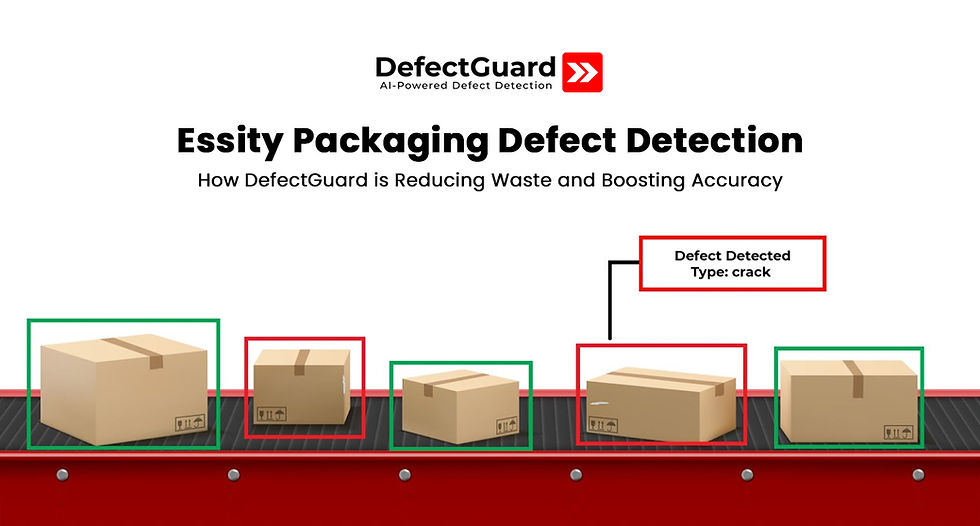Cut Costs and Catch Every Flaw: Smart Packaging Inspection with DefectGuard
- pyadav52
- Jun 18
- 4 min read

Introduction
In today’s fast-paced packaging environment, quality cannot wait—it must be ensured at line speed, 24/7. Manual inspections lag far behind the needs of modern production volumes. DefectGuard by Brightpoint AI offers a solution: harnessing AI-driven visual inspection to deliver real-time defect detection, reduce waste, and maximize throughput—all while improving quality and lowering costs.
This innovative tool eliminates the reliance on human inspectors and error-prone rule-based systems, enabling packaging manufacturers to stay competitive in a demanding market. Let’s explore how DefectGuard delivers transformative benefits tailored for packaging.
Challenges in Packaging Defect Detection
Before AI-powered tools like DefectGuard, the packaging industry faced several challenges that directly impacted production quality, speed, and costs:
1. Human Error in Visual Inspection
Even experienced operators miss subtle or intermittent defects due to fatigue, lighting, or production speed—resulting in defective products reaching customers.
2. Inconsistent Quality Checks Across Shifts
Manual inspections often vary between shifts or inspectors, leading to inconsistent quality standards.
3. Delayed Defect Identification
Traditional systems detect defects too late—often after full batches are complete—leading to rework, waste, or customer returns.
4. Lack of Root-Cause Visibility
Without proper tracking or analytics, teams struggle to identify why defects are happening, which limits process improvements.
5. Scaling Inspections for New SKUs
With product variations, seasonal designs, and rapid SKU changes, traditional inspection methods can’t keep up without constant reprogramming or retraining.
These challenges underscored the need for a more scalable, accurate, and intelligent approach—enter DefectGuard.
Key Features
1. Real‑Time Defect Detection
DefectGuard continuously monitors conveyor lines with high-resolution cameras, spotting defects such as punctures, misprints, seal issues, or tears as they happen. Trident Information found that AI-based visual inspection significantly improves accuracy, efficiency, and consistency during packaging and labeling processes
2. Advanced Analytics & Root-Cause Insights
Every detected defect is logged—complete with timestamp, category, and image—into a centralized analytics dashboard. This empowers teams to identify defect trends and root causes, enabling targeted process improvements. Brightpoint AI’s dashboard supports predictive analytics for proactive quality control .
3. Self-Learning AI Models
With both supervised and unsupervised training modes, DefectGuard adapts quickly—even to new defect types—using minimal labeled data. It learns from each inspection cycle, continuously refining detection levels .
4. Plug & Play, No Expertise Required
Setup is user-friendly—no data science background needed. Simply connect cameras, upload “good” and “bad” samples, and start the training; many models take less than 30 minutes to configure, delivering rapid ROI .
5. Edge or Cloud Deployment
Regardless of infrastructure constraints, DefectGuard fits in. Run AI inference on edge devices for ultra-low latency or connect to cloud systems for centralized analytics and data storage—while ensuring data security .
Enhancements vs. Traditional Inspection
Higher Accuracy, Zero Fatigue
AI models consistently outperform human inspectors, detecting minuscule or irregular defects that the naked eye misses—operating flawlessly 24/7.
Reduced Waste & Enhanced Speed
By catching packaging flaws early, manufacturers cut rework and scrap dramatically—key drivers of improved throughput and cost optimization.
Digital Traceability
Every inspection is logged, time-stamped, and stored—ideal for compliance, customer assurance, and dispute resolution.
Scalability & Flexibility
Easily adapt AI models to different package types, print runs, and substrates—whether changing labels mid-shift or redesigning cartons during seasonal runs .
Predictive Quality Control
With trend data and real-time alerts, teams can detect issues before they escalate, transitioning from reactive QA to proactive maintenance .
Integration
DefectGuard seamlessly integrates into packaging lines thanks to:
Camera Compatibility: Supports still or video cameras—including existing setups
Control System Hook-Up: Sends pass/fail signals to sorters and stoppers
Dashboard Connectivity: Links with MES, ERP, and Business Intelligence tools for analytics
Security & Compliance: Offers on-premise edge deployment to meet data privacy and regulatory demands
Success Stories
Food Packaging Efficiency
A food-packaging plant detected intermittent seal failures using DefectGuard’s analytics, resolving the malfunction before shipments. The result: 30% less waste and enhanced line uptime.
Pharmaceutical Label Quality
In pharma, ensuring labeling accuracy is critical. With AI inspection, one client reduced label misprint errors by 95%, preventing costly recalls and reinforcing compliance .
Beverage Glass Inspection
Brightpoint AI worked with a bottling plant, enabling real-time detection of cracks and chips. As a result: zero in-field breakage incidents, dramatically lowered claims, and increased consumer trust .
Getting Started
Demo & Assessment
Brightpoint AI team evaluates your current line, defect types, and objectives.
POC & Pilot
Deploy cameras and train AI on 100–500 images per defect type to verify system performance.
Scale deployment
Roll out across shifts, install dashboards, and integrate with existing production controls.
Continuous Optimization
Use feedback loops to refine AI models and address new defect types. Dashboards aid continuous improvement cycles.
FAQ
1. What defects can DefectGuard detect? It identifies misprints, seal failures, label misalignments, punctures, foreign objects, and more across cartons, films, bottles, labels, and flexible packaging .
2. How fast is model training? Typically under 30 minutes—provide a few hundred examples, and the system is ready to start inspections .
3. Does it require cloud connectivity? No—edge deployment supports local inference. Cloud integration is optional for analytics and centralized management.
4. Can it work with existing hardware? Yes—most cameras and automation systems are supported, or Brightpoint AI can assist in adding compatible components .
5. What ROI can be expected? Manufacturers often see 20–40% waste reduction, 30% fewer defects, and faster time-to-value, often within weeks of deployment .
Conclusion
In the packaging industry, where precision and speed make the difference, DefectGuard by Brightpoint AI delivers a step-change in quality assurance. By combining ultra-accurate defect detection, advanced analytics, and seamless integration, packaging production becomes faster, safer, and more cost-effective. Whether you produce food, pharma, beverages, or consumer goods, DefectGuard helps you scale high-volume operations—without sacrificing quality.









Comments